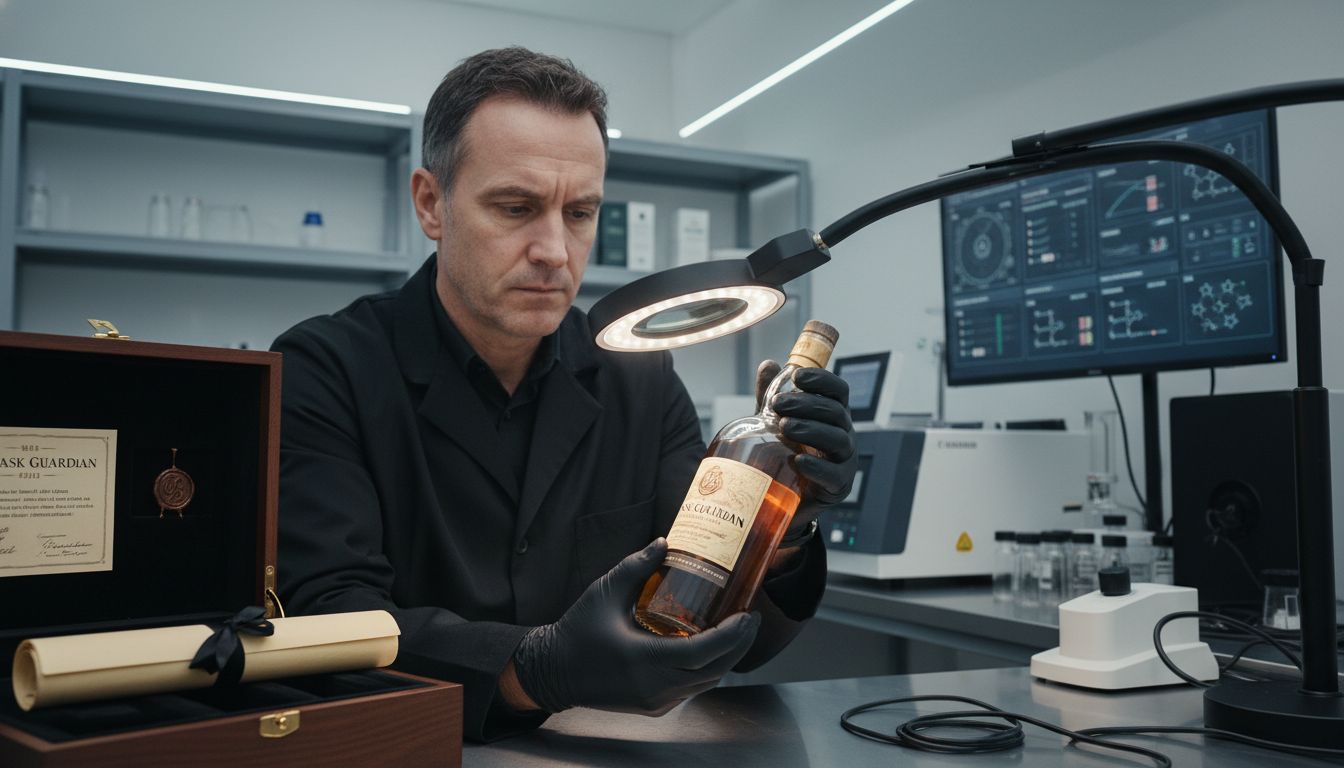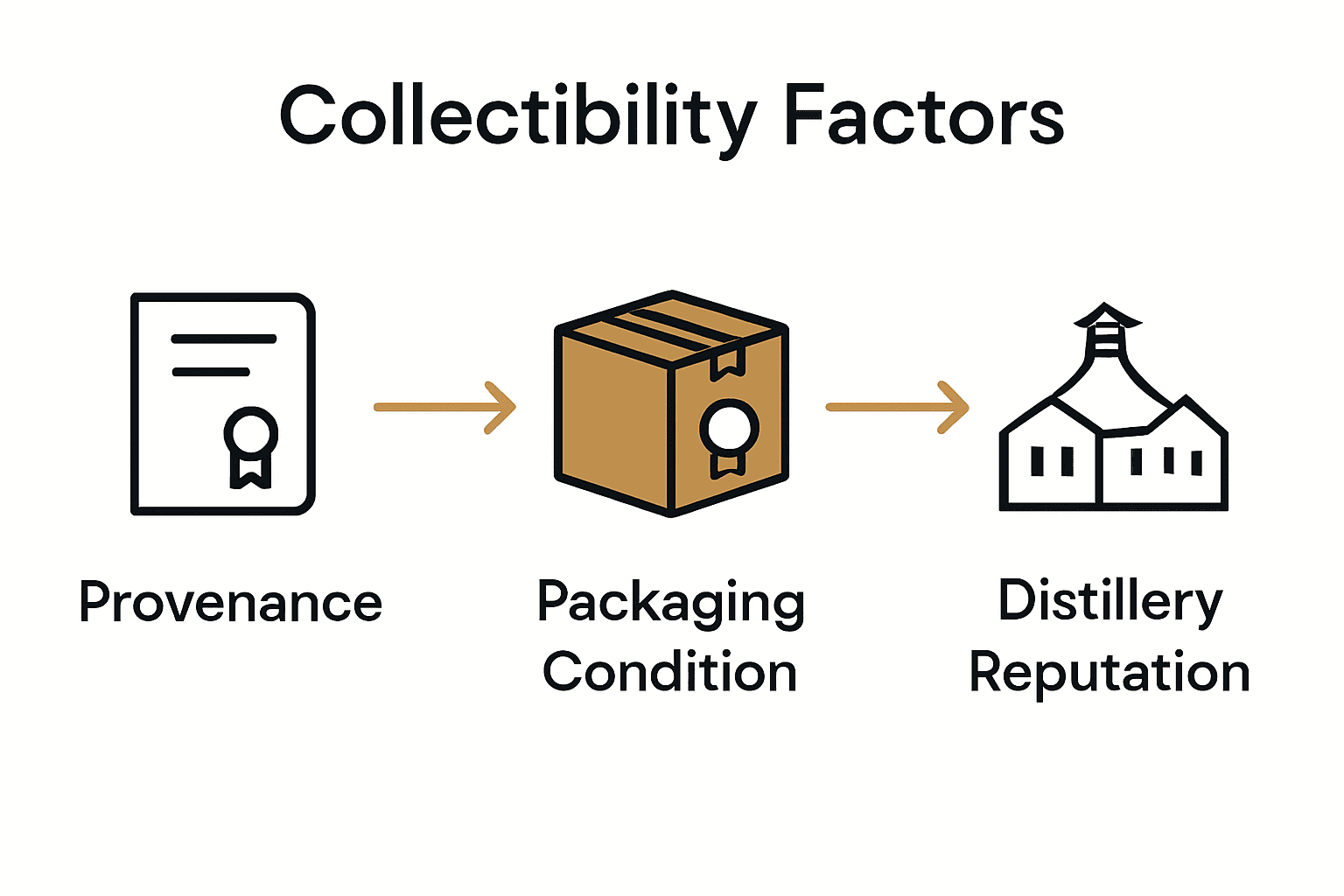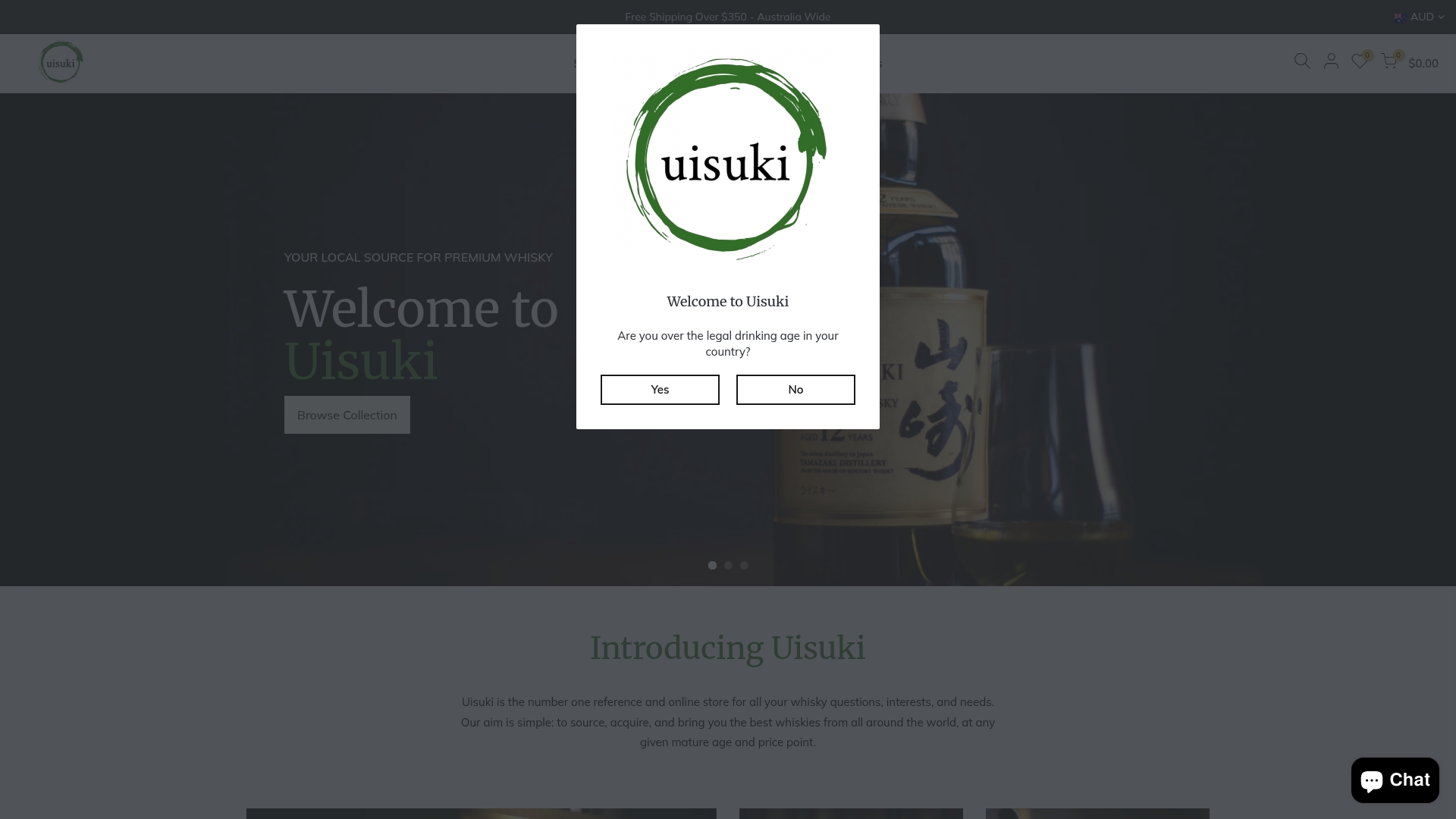Whisky collecting goes far beyond enjoying the occasional dram. For serious collectors, rare whisky bottles are more than just drinks—they are liquid artifacts shaped by history, artistry, and scarcity. Over 70 percent of rare bottles owe their value to factors like limited runs, closed distilleries, and uniquely crafted batches. Understanding what makes a bottle rare helps collectors avoid costly mistakes and uncover true treasures in a market where authenticity is everything.
Table of Contents
- Core Definition of Rare Whisky Bottles
- What Makes a Whisky Bottle Rare
- Types of Rare Bottles and Regions
- Investment Value and Collectibility Factors
- Risks, Market Trends, and Pitfalls
Key Takeaways
| Point | Details |
|---|---|
| Definition of Rare Whisky | Rare whisky bottles are defined by their limited production, unique origins, and exceptional craftsmanship, rather than solely by age. |
| Investment Value | The potential financial appreciation of rare whiskies hinges on factors like provenance, distillery reputation, and packaging condition. |
| Market Risks | Collectors face challenges with counterfeit products and market volatility, necessitating careful research and expert guidance for successful investments. |
| Regional Significance | Certain geographic regions and historical contexts greatly influence the desirability and collectibility of rare whisky bottles. |
Core Definition of Rare Whisky Bottles
Whisky collecting transcends casual drinking. Rare whisky bottles represent extraordinary liquid treasures that combine historical significance, craftsmanship, and scarcity into singular collector’s items. According to Wikipedia, vintage spirits are defined as “old, discontinued, or otherwise rare bottles of liquor” where collectibility fundamentally depends on rarity, with age serving as a secondary consideration.
The definition of a rare whisky bottle involves multiple complex factors beyond mere age. These include limited production runs, discontinued distilleries, unique cask selections, historical provenance, and exceptional craftsmanship. Some rare whiskies emerge from closed distilleries, making them irreplaceable snapshots of whisky-making history. Others gain rarity through minimal production quantities or special commemorative releases that were never intended for widespread distribution.
However, collectors must exercise caution. Academic research from Glasgow University warns that the whisky market faces significant challenges with fraudulent products. Particularly concerning are bottles purporting to be rare single malts supposedly distilled between the 19th and mid-20th centuries, which are actually recently produced counterfeits. This underscores the importance of provenance, authentication, and expert verification when pursuing rare whisky investments.

Key characteristics that define rare whisky bottles include:
- Extremely limited production numbers
- Discontinued or closed distillery origins
- Unique maturation processes
- Historical or cultural significance
- Exceptional condition and original packaging
For enthusiasts eager to explore this fascinating world further, learn more about selecting rare whiskies in our comprehensive collector’s guide.
What Makes a Whisky Bottle Rare
Rarity in the whisky world is a nuanced concept that goes far beyond simple scarcity. Exceptional whiskies emerge from a complex interplay of factors that transform an ordinary bottle into a coveted collector’s prize. According to Channel News Asia, industry expert James Walker defines a rare whisky as something “not released every year” - potentially appearing only once every five to ten years, or potentially never again.
The rarity of a whisky bottle stems from multiple distinctive attributes. These include extraordinary production circumstances such as limited edition releases, whiskies from defunct distilleries, unique cask finishes, and exceptional aging processes. Collectors particularly value bottles that represent a singular moment in whisky-making history - perhaps a final run from a closing distillery, a commemorative release, or a experimental batch that will never be replicated.
Certain specific characteristics dramatically elevate a whisky’s collectible status. Bottles with exceptional provenance, those matured in rare or unusual casks, or produced during significant historical periods become prized possessions. Factors like minimal production quantities, unique distillation techniques, and bottles from legendary or now-closed distilleries can exponentially increase a whisky’s desirability among serious collectors.
Key indicators of a rare whisky bottle include:
- Extremely limited production numbers
- Historical significance
- Unique maturation or production techniques
- Bottles from closed or legendary distilleries
- Exceptional condition and original packaging
- Significant age or vintage
- Commemorative or special edition releases
For enthusiasts looking to dive deeper into the world of rare whisky collecting, discover expert insights in our comprehensive guide to rare whiskies.
Types of Rare Bottles and Regions
Rare whisky bottles represent a fascinating global landscape of exceptional spirits, with unique characteristics emerging from different regions and distilleries. Regional distinctions play a crucial role in defining a whisky’s collectible status, with certain locations producing exceptionally sought-after bottles. Wikipedia highlights an excellent example with Midleton Very Rare, a premium Irish whiskey where “each year, a new bottling is specially created by the Master Distiller, using whiskeys handpicked from the distillery’s warehouses” - precisely the kind of meticulous approach that generates collector interest.
Different global regions contribute distinctive rare whisky types. Scottish single malts from closed distilleries like Port Ellen or Brora command astronomical prices. Japanese whiskies from legendary producers like Karuizawa represent another pinnacle of collectibility. American bourbon enthusiasts prize vintage expressions, such as Eagle Rare, which offers remarkable aged variants like their 10, 12, and 17-year-old bottlings that capture the essence of Kentucky’s distilling tradition.
The most collectible rare whisky bottles typically emerge from specific categories that transcend mere regional boundaries. These include limited annual releases, experimental cask finishes, commemorative editions, and bottles from permanently closed distilleries. Collectors particularly value whiskies that tell a unique story - whether through exceptional craftsmanship, historical significance, or extraordinary production circumstances.
Key regions producing exceptional rare whisky bottles include:
- Scotland (Highlands, Islay, Speyside)
- Japan (Hokkaido, Honshu)
- Ireland (Dublin, Midleton)
- United States (Kentucky, Tennessee)
- Canada (British Columbia)
For whisky enthusiasts eager to explore the intricate world of rare bottle collecting, discover seven must-know examples of rare whiskies for serious collectors.
Investment Value and Collectibility Factors
Rare whisky collecting represents a sophisticated investment landscape where value extends far beyond simple liquid assets. Market dynamics in the whisky world are complex, with multiple factors influencing a bottle’s potential financial appreciation. According to South China Morning Post, global spirits expert Jonny Fowle from Sotheby’s highlights that packaging plays a critical role in determining a vintage whisky’s value - a nuanced insight that goes beyond mere contents.
The investment potential of rare whisky bottles depends on intricate combinations of historical, qualitative, and market-driven elements. Collectors and investors evaluate bottles based on provenance, distillery reputation, production methods, age statement, limited release numbers, and overall condition. Unopened bottles with pristine original packaging typically command significantly higher prices, as they represent untouched historical artifacts that maintain their potential collector value.

Certain fundamental characteristics dramatically influence a whisky’s collectibility and potential financial appreciation. These include the bottle’s production history, the reputation of its distillery, unique maturation processes, and the narrative surrounding its creation. Bottles from defunct distilleries, special commemorative releases, and those representing significant moments in whisky-making history often become extraordinarily valuable investment opportunities for discerning collectors.
Key investment value determinants include:
- Original packaging condition
- Bottle and seal integrity
- Limited production numbers
- Historical significance
- Provenance documentation
- Distillery reputation
- Age and vintage
- Market demand trends
For enthusiasts seeking deeper insights into navigating the complex world of whisky investments, explore our expert guide on identifying rare whiskies.
Risks, Market Trends, and Pitfalls
The rare whisky market is a complex ecosystem fraught with significant challenges that demand sophisticated understanding from collectors and investors. Fraudulent practices represent a critical concern in this sophisticated marketplace. Research from the University of Glasgow reveals a major threat to the whisky industry: the global production of fraudulent products, including bottles purporting to be rare single malts supposedly distilled between the 19th and mid-20th centuries, which are actually recently produced counterfeits.
Technological advancements are emerging as powerful tools in combating market risks. Cutting-edge research from ArXiv demonstrates that machine learning models can now achieve over 99% accuracy in brand identification across commercial samples, offering unprecedented protection against brand substitution and quality control issues. This technological intervention represents a significant breakthrough in authenticating high-value whisky investments.
The volatile nature of the rare whisky market demands strategic navigation from potential collectors. Price fluctuations, authenticity challenges, and the potential for significant financial loss require meticulous research and expert guidance. Successful collectors develop comprehensive strategies that include thorough provenance verification, understanding market trends, maintaining optimal storage conditions, and building relationships with reputable dealers and auction houses.
Key risks and market considerations include:
- Prevalence of counterfeit bottles
- Significant price volatility
- Complex authentication processes
- Storage and preservation challenges
- Fluctuating collector interest
- Potential for significant financial investment
- Importance of expert verification
- Evolving market dynamics
For enthusiasts seeking to navigate these complex waters, explore our expert guide on identifying rare whiskies.
Discover and Secure Your Own Rare Whisky Treasures Today
Whisky collectors understand the thrill and challenge of finding those exceptionally rare bottles with historical significance and limited production. If you are passionate about adding extraordinary whiskies to your collection or investment portfolio, navigating authenticity and provenance can be daunting. At Uisuki, we specialise in offering a carefully curated range of premium and rare whiskies, including sought-after older bottlings that align perfectly with the article’s themes of rarity, provenance, and extraordinary craftsmanship.

Step into a world where each bottle tells a story. Explore our Older Bottling’s – Uisuki.com.au collection to find carefully selected rare expressions with verified origins. Whether you seek renowned single malts or unique commemorative releases, our platform supports your passion with expert guidance, detailed descriptions, and seamless purchasing options. Visit Uisuki now and take confident steps to enrich your whisky collection with genuine rarities before they disappear from the market.
Frequently Asked Questions
What defines a rare whisky bottle?
Rare whisky bottles are defined by factors such as limited production runs, discontinued distillery origins, unique cask selections, historical significance, and exceptional craftsmanship.
What makes a whisky bottle collectible?
The collectibility of a whisky bottle is influenced by its rarity, age, provenance, unique production techniques, and historical relevance. Bottles from closed distilleries or special editions tend to be highly sought after.
How can collectors ensure the authenticity of rare whisky bottles?
Collectors should verify provenance, seek expert authentication, and avoid bottles with questionable history. Researching a distillery’s reputation and production methods also helps ensure authenticity.
What are the key risks in investing in rare whisky?
Investing in rare whisky involves risks such as the prevalence of counterfeit bottles, price volatility, and complex authentication processes. Thorough research and expert guidance are essential for navigating these challenges.

